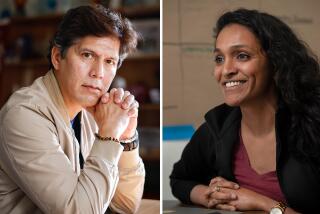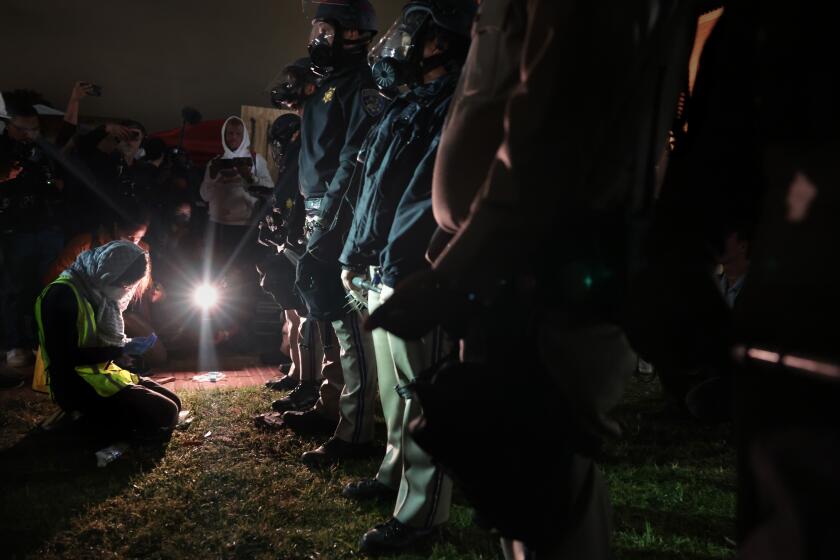Column: ‘It’s almost like a death watch’: Severely ill homeless people are at risk of dying on the streets of Hollywood
Raquel was the one who got to me.
Not that it was easy to forget all the other people I saw while touring Hollywood in the pre-dawn hours Friday.
Photographer Francine Orr and I were traveling with Anthony Ruffin and Rudy Salinas of Housing Works, a nonprofit that steers homeless people into housing and services. Ruffin and Salinas were hoping to use the forecast of rain to talk people into shelter, or into hospitals, depending on the need.
Housing Works is one of the many supporters of Measure HHH on the Nov. 6 ballot in Los Angeles. It would raise $1.2 billion for housing, with the county expected to provide needed services for residents. Salinas said the current critical housing shortage is a killer. Even when Housing Works manages to persuade sick, resistant homeless people to move inside, there’s nowhere to put them.
We came upon a bus stop bench near the Hollywood Bowl and saw a man so disoriented, he didn’t know how long he’d been homeless, where he was from, or what he would do when the rains came.
On Gower Street, near Hollywood Presbyterian Church, Salinas jerked his car to the curb when we saw what looked like a scene out of “Mad Max.”
A razor-thin urchin popped up though a manhole, then disappeared back underground. When he surfaced again, Daniel Martinez, 30, said he’d been homeless for seven years. He claimed he was trying to retrieve a ball that had gone down a storm drain and into the sewer, but we all wondered if there might be a subterranean village down there. In the U.S. homeless capital, who could be shocked?
On Sunset we met up with Eddie “Snake” Carter, 65, a wheelchair-bound double amputee. Carter is on a list called the Hollywood 14, the most chronically ill people in the neighborhood. Ruffin had managed to find housing for him recently, but Carter was a street dweller for 15 or 20 years, and after that much exposure, normal living is what’s scary for some people. It takes time.
Ruffin saw that Carter’s hands and eyes were badly puffed. The last time he was like that, Ruffin said, it turned out to be a staph infection, and he underwent his second amputation. On Friday, Ruffin managed to persuade Carter to accept a ride to the hospital.
No such luck with Rachel “Raquel” Phillips.
She lay asleep on the sidewalk in her usual spot at Highland and Franklin, one of the busiest intersections in Hollywood. Phillips was curled on her right side, facing a hedge. Sometimes she sits and stares at that hedge for hours.
It’s a little intimidating to stand there and watch headlights curving down the hill on Highland. Ruffin and Salinas were worried that if it rained, a car could skid out of control, jump the curb and take Raquel out.
A urine stain ran from Raquel all the way down to the gutter. The pavement is permanently discolored because Raquel has been there, in that same spot, for 15 years.
Fifteen years.
Standing at her side, I felt a mix of anger, sadness, shame. It couldn’t be any more obvious that she’s too incapacitated to act in her own best interest, and if the law doesn’t put her welfare and our duty first, it has to be changed.
“There’s dozens of people like this, all over L.A.,” said Ruffin.
We need to put an intentional focus on the least and the lost, which is what Jesus did.
— The Rev. Kathy Cooper Ledesma, Hollywood First United Methodist Church
Ruffin and others, including members of the Hollywood First United Methodist Church, have tried desperately to help. The Rev. Kathy Cooper Ledesma said she supports civil liberties, but Raquel is so gravely ill, it’s unconscionable that she be given the right to slowly deteriorate.
“It’s a crime for any decent society to have children and the elderly and mentally ill folks living on the street. It’s just a sin,” said Cooper Ledesma.
She said she usually refrains from recommending how her congregants should vote, but she hasn’t been shy about sharing her support for Measure HHH. It might not help someone like Raquel, who seems to need hospitalization more than housing. But given the huge homeless population — more than 43,000 in Greater Los Angeles — Cooper Ledesma fears more people will end up like Raquel if they don’t get into supportive housing.
“We need to put an intentional focus on the least and the lost, which is what Jesus did,” she said.
Once, Ruffin managed to get Raquel hospitalized, but she was back out quickly. On more than one occasion, Ruffin said, county health workers have determined she was not sick enough to meet the legal requirements for an involuntary psychiatric commitment.
Ruffin was praying for rain. If it came down hard enough, he would call the county and ask if they’d come see if Raquel could be hospitalized for her own health and safety.

“All I can do is wait till it rains,” he said. “It’s almost like a death watch.”
Indeed, three people on the Hollywood 14 list have died since 2013.
It didn’t rain hard enough for Raquel’s benefit. Ruffin got down on the pavement, looked into her eyes and asked her to please accept some help. She told him her mother would be coming by to write a check so she could stay in a motel.
Ruffin got back to his feet.
“Her mother’s been dead for years,” he told me.
It wasn’t all gloom and doom Friday. I met up midmorning with L.A. Mayor Eric Garcetti, who’s been stumping for Measure HHH, arguing that in some cases, supportive housing can cost less than all the public safety and hospitalization costs associated with homelessness.
Garcetti was visiting a woman we met together in May while touring a Hollywood drop-in center. The mayor’s staff helped get Natalia Franco off the streets, and since mid-August she’s been living at Step Up on Vine, a heralded nonprofit that provides housing and mental health services.
Franco said she’s still adjusting to her new life indoors, but it’s good to be “out of the weather.”
Later in the day, I heard back from Ruffin, who said he’d make another attempt on Monday to get Raquel to a hospital.
“It’s like a waiting game, waiting on her to get really sick or die,” said Ruffin. “And you’ve got people like this all over L.A.”
Get more of Steve Lopez’s work and follow him on Twitter @LATstevelopez
ALSO
If you can stay homeless in Venice, why get off the street?
Homelessness became a crisis in L.A. during the 1980s, but the city struggled to act
More to Read
Start your day right
Sign up for Essential California for news, features and recommendations from the L.A. Times and beyond in your inbox six days a week.
You may occasionally receive promotional content from the Los Angeles Times.







